|
Petro Novo Primitive:
Art or Graffiti?
Art
& Article
by Jorge Conesa-Sevilla
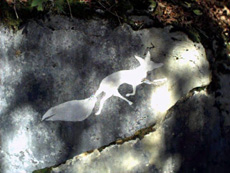
Madame Renard the Fox

Deer
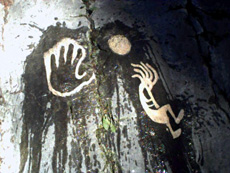
"Koko"
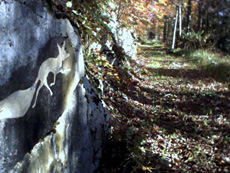
Fox Walk
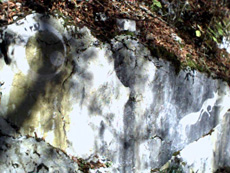
Fox and (upper left) Moon
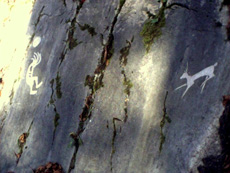
"Koko" and Deer
ART
OR GRAFFITI?
by
Jorge Conesa-Sevilla
In the
past, I have enjoyed doing temporary nature art meant to
disappear with the lick of an ocean wave or the kiss of
the wind. This series is different. Before I began, I had
to think carefully about the eco-ethical consequences of
making an enduring mark on an otherwise natural landscape.
Even if the "blemish" happens to be art, it could
change the semiotic coda (it does) and the overall experience
of that PLACE for somebody else who may not appreciate seeing
man-made rock engravings, however meaningful or pleasing
these might be for ME.
My son
and daughter even asked me to ponder the "G" word:
graffiti. "Papa, are you sure this is not your own
type of graffiti? Aren't you merely rationalizing it as
art?" Yes, that is the way they talk. Tough job being
their parents...made us sharper. I argued weakly that some
"graffiti" was ART. But at the core of my better
argument was that it was the INTENTION that defined the
object, the product.
Yes,
I can "deface" any surface with frustration, anger,
or mischief. Equally, I can "glorify" not only
myself but also my environment—natural or synthetic—when
my intentions are noble, when my emotions are in harmony,
and when my thoughts are subdued. And there are also the
ironies; historical and primitive art show both. In the
castle of Valangin, near where I live, there is graffiti
engraved on its ancient walls, even cursing words. But the
cursing words and sexual meanings are kept alongside the
boring paintings of stuffy Swiss Neuchâtel nobility.
History can glorify anything, even portly middle-aged men
who held slaves. I recently met a British man who believes
he is nobility, is portly, plays golf, and thinks money
is art. But that is another story.
Perhaps,
I argued back, prehistoric cave art was an act of defiant
defacing and graffiti. The Cro-Magnon elders repeatedly
told the youngsters: "It is forbidden, taboo, to represent
an animal or a person, inside a cave, while under the effects
of hallucinogens." And teenagers, being teenagers even
then, typical of a developmental phase of intense self-consciousness
and the search for identity, got high, penetrated the cave's
deepest recesses, and represented animals and their own
hunting exploits with soot and ochre. Who knows for sure?
My children laugh a nervous laugh. "I am winning my
argument," I think.
"Is
Christo defacing bridges, parks, and hills?" I ask
them. "Who is Christo?" They asked. "Ha!
They don't know."
I am
not a photographer. I adore by touching and feeling, caressing
and smelling. I adore my mountain and its lonely woods.
I adore its wildlife. I adore my walking in their space,
now my PLACE, and participating in their natural history--on
my hands and knees like a born-again quadruped. I know where
Madame Renard, fox, hides and lives. Last spring, I visited
her den and checked how her kits were coming along. I know
by studying her scat and the carcasses she leaves behind
that she is eating well. I adore her, her life, so I carved
her image.
I know
where Chevreuils, deer, lay down to sleep at night. I have
seen their blood spilled by hunters. Two days ago I tracked
blood uphill to a body that a lazy killer did not bother
to finish off. I have also visited the bedchambers of Chamois,
their fluffy hair sticking out of the snow and ice like
frozen velvet. I know what beeches the Sangliers, boars,
like to visit in search of beechnuts. I have seen the aftermath
of their digging for truffles. So I carved their images
as well.
One night,
I saw the crescent moon rising from my hammock (an intentionally
ambiguous sentence). At the same time, I saw Madam Renard
chasing after shadows. So I carved the moon.
I often
feel lonely for ecopsychological meaning. So I carved Kokopeli
in Switzerland so that it can protect the farmer's crops
and keep me company at the same time. I did one self-centered
thing: I carved the image of my left hand, like the ancients
did and many children still do, because it was fun, yes,
but also because I wanted to leave something of me THERE
as well.
I will
continue doing this kind of subversive petro-novo-primitive
art, not because I want to begin an artistic trend but because
I adore by touching and feeling and by caressing and smelling.
I carve because I adore my mountain and its lonely woods
and because I adore its wildlife. I carve because I adore
my BEING in this PLACE.
**********************
Most
of the images you see above are, technically speaking, abrasion
petroglyphs, and more specifically, they are Sgraffitos,
created by removing (by abrasion with diverse hand tools--e.g.,
carbide-tipped metal files) the weathered outer layer of
calciferous Jurassic age rocks. An abraded intaglio, the
actual Sgraffito is a more or less concaving reduction of
this outer, weathered rock layer from five to ten millimeters
in depth. A second technique I use is bruising or lightly
pounding the weathered layer with a sharp tool in order
to produce precise and small indentations. In addition to
removing the weathered layer of these rocks, bruising often
goes deeper into the rock matrix exposing quartz layers
and faceting them at the same time. Exposing the quartz
in this manner, and when viewed from certain angles, gives
the finished petroglyph a natural iridescence. The faceted
areas are not anamorphosis.
The
rock faces that I select for "communion" are a
scallop-shaped older rock matrix that, unlike most of the
surrounding and eroded deposits, has endured longer erosive
processes (otherwise the scalloped erosion would not be
seen).
Thus
far, most of the sgraffitos are recognizable astromorphic,
anthropomorphic, and zoomorphic motifs (respectively, for
example, the moon, Kokopeli, and animals), except for the
more abstract serpentine designs abraded on the long ridges
of naturally scalloped and eroded rocks. Seeing that the
scalloped forms already insinuate a large figurative and
natural representation of these bivalves, I use their "shell"
ridges, the ones that are least likely to endure further
erosion, to create abstract serpentine-dendritic sgraffitos
that run the length of these ridges.
I
have experimented with several 'rigid,' serpentine patterns.
One pattern, mimics a typical alternating orchid flower
budding pattern of a zigzag stem. The other is also a zigzag
pattern that mimics the same branching phenomena in certain
birch trees. I chose a zigzag pattern so that maximum texture-shape
contrast could be obtained against the mostly sinuous and
soft-curving vertical ridges exhibited by most of these
scallop rock formations.
The
scalloped rock faces usually follow the grade of this particular
mountain, a very steep 40-60 degrees. This suggests that,
at an earlier geological time, they might not have been
at this angle and that the erosive forces of water, tumbling
debris, and other materials shaped them to today's present
angle. They are also the strongest rock matrix on that mountain.
The non-clastic enduring characteristic of the scalloped
formation makes them ideal for Sgraffito art. Every now
and then I find unusual protuberances on the same rocks
that insinuate a certain bas-relief image, (e.g., the hand-print)
or part of a complete form or even a more complete figure.
It is fairly easy, then, to accentuate the periphery of
the already existing bas-relief with Sgraffito techniques.
This dual approach makes the process more sculptural. I
imagine that our ancestors were also able to "project"
these suggested bas-relief shapes and work toward a finished
form. This much has been suggested for the genesis of paintings
in some of the Spanish pre-historic cave sites.
*****
***** ***** ***** ***** *****
Jorge
Contesa-Sevilla PhD,
has a triple degree in Biology, Philosophy and Psychology
from Humbolt State University in Arcata, California. He
currently lives with his wife in Switzerland, and works
at the
Sleep Laboratory at the University Hospital in Bern. Jorge
teaches Ecology, Art & Psychology of Aesthetics classes
and workshops and offers a wide range of ecological services
in Italy, Switzerland and Spain through his organization,
Ecopsychologie.
|